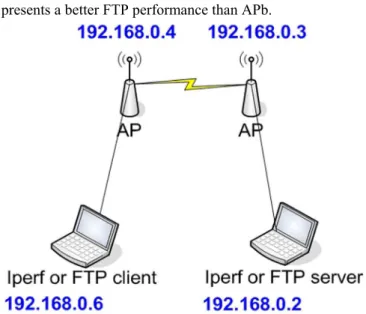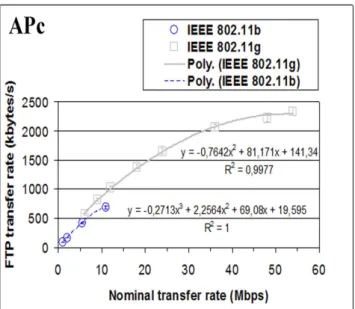Abstract—The importance of wireless communications has been growing. Performance is a very relevant issue, leading to more reliable and efficient communications. Laboratory measurements are made about several performance aspects of Wi-Fi (IEEE 802.11 b, g) point-to-point links. A contribution is given to evaluation of this technology through performance comparisons, using available access points from Enterasys Networks (RBT-4102) and wireless routers from Linksys (WRT54GL). Detailed results are presented and discussed, namely at OSI levels 4 and 7, from experiments involving TCP, UDP and FTP: TCP throughput, jitter, percentage datagram loss and FTP transfer rate.
Index Terms—WLAN, Wi-Fi, IEEE 802.11b, IEEE 802.11g, Point-to-Point Links, Wireless Network Laboratory Performance Measurements.
I. INTRODUCTION
Wireless communications are increasingly important for their versatility, mobility and favourable prices. It is the case of microwave based technologies, e.g. Wi-Fi.
The importance and utilization of Wi-Fi have been growing for complementing traditional wired networks. Wi-Fi has been used both in ad hoc mode and infrastructure mode. In this case an access point, AP, is used to permit communications of Wi-Fi devices with a wired based LAN through a switch/router. In this way a WLAN, based on the AP, is formed. Wi-Fi has reached the personal home, forming a WPAN, allowing personal devices to communicate. Point-to-point and point-to-multipoint configurations are used both indoors and outdoors, requiring specific directional and omnidirectional antennas. Wi-Fi uses microwaves in the 2.4 and 5 GHz frequency bands and IEEE 802.11a, 802.11b
Manuscript received March 22, 2009. Supports from University of Beira Interior and FCT (Fundação para a Ciência e a Tecnologia)/POCI2010 (Programa Operacional Ciência e Inovação) are acknowledged. We acknowledge Enterasys Networks for their availability.
J. A. R. Pacheco de Carvalho is with the Informatics Centre and the Remote Detection Unit, University of Beira Interior, 6201-001 Covilha, Portugal (phone: +351 275 319 810; fax: +351 275 319 886; e-mail: pacheco@ ubi.pt).
P. A. Gomes, H. Veiga, and N. Marques are with the Informatics Centre and the Remote Detection Unit, University of Beira Interior, 6201-001 Covilha, Portugal (e-mails: pgomes@ubi.pt; hveiga@ubi.pt; nmarques@ubi.pt).
C. F. Ribeiro Pacheco is with the Remote Detection Unit, University of Beira Interior, 6201-001 Covilha, Portugal (e-mail: a17597@ubi.pt).
A. D. Reis is with the Remote Detection Unit, University of Beira Interior, 6201-001 Covilha, Portugal and with the Department of Electronics and Telecommunications/ Institute of Telecommunications, University of Aveiro, 3810 Aveiro, Portugal (e-mail: adreis@ubi.pt).
and 802.11g standards [1]. Nominal transfer rates up to 11 (802.11b) and 54 Mbps (802.11 a, g) are permitted. CSMA/CA is the medium access control. The 802.11 architecture has been studied in detail, including performance analysis of the effective transfer rate [2]. An optimum factor of 0.42 was determined for the effective transfer rate in 11 Mbps point-to -point links, giving an effective transfer rate of 4.6 Mbps. Wi-Fi performance is available in indoor environments [3].
Performance has been a very important issue, resulting in more reliable and efficient communications. New telematic applications are specially sensitive to performance, depending on application requirements. Application characterization has been discussed [4]. Several measurements have been made for 2.4 GHz Wi-Fi [5], as well as WiMAX and high speed FSO [6,7]. In the present work further Wi-Fi results arise, through OSI levels 4 and 7. Wi-Fi (IEEE 802.11 b,g) is evaluated and performance is compared in laboratory measurements of point-to-point links, using available access points.
The rest of the paper is structured as follows: Chapter 2 presents the experimental details i.e. the measurement setup and procedure. Results and discussion are presented in Chapter 3. Conclusions are drawn in Chapter 4.
II. EXPERIMENTAL DETAILS
Two types of experiments were carried out, mentioned as Expb and Expc. Expb used Enterasys RBT-4102 level 2/3/4 access points (APb), with firmware version 1.1.51, IEEE 802.11a/b/g transceivers, dual-band diversity antennas [8], and 100-Base-TX/10-Base-T Allied Telesis AT-8000S/16 level 2 switches [9]. The transceivers were based on the Atheros 5213A chipset. The configuration was for minimum transmitted power and equivalent to point-to-point, LAN to LAN mode, using the internal antenna. Expc used Linksys WRT54GL wireless routers [10], with a Broadcom BCM5352 chip rev0, firmware DD-WRT v24-sp1-10011 [11] and the same type of level 2 switch. The wireless mode was set to bridged access point. In both Expb and Expc, interference free communication channels were used. WEP encryption was not activated. No power levels above the minimum were required as the access points were very close (30 cm).
Both types of experiments, Expb and Expc, were made in point-to-point mode using the laboratory setup shown in Fig. 1. Measurements were made using TCP and UDP communications at OSI level 4, as mentioned in [7],
Laboratory Performance Studies of IEEE 802.11
b, g Point-to-Point Links through TCP, UDP and
FTP Experiments
J. A. R. Pacheco de Carvalho, P. A. Gomes, H. Veiga, C. F. Ribeiro Pacheco, N. Marques, A. D. Reis Proceedings of the World Congress on Engineering 2009 Vol I
WCE 2009, July 1 - 3, 2009, London, U.K.
permitting network performance results to be recorded. For a TCP connection, TCP throughput was obtained. For a UDP test with a given bandwidth parameter, UDP throughput, jitter and percentage loss of datagrams were obtained. TCP packets and UDP datagrams of 1470 bytes size were used. A window size of 8 kbytes and a buffer size of the same value were used for TCP and UDP, respectively. One PC, with IP 192.168.0.2 was the Iperf server and the other, with IP 192.168.0.6, was the Iperf client. Jitter, which can be seen as the smooth mean of differences between consecutive transit times, was continuously computed by the server, as specified by RTP in RFC 1889 [12]. This scheme was also used for FTP measurements, where FTP server and client applications were installed in the PCs with IPs 192.168.0.2 and 192.168.0.6, respectively.
Batch command files were written to enable the TCP, UDP and FTP tests. The results were obtained in batch mode and written as data files to the client PC disk.
III. RESULTS AND DISCUSSION
Both APb and APc access points were configured, for each standard IEEE 802.11 b, g, with several fixed transfer rates. For every fixed transfer rate, measurements were made, for both Expb and Expc. In this way, for each experiment type, data were obtained for comparison of the laboratory performances of IEEE 802.11 b and 802.11g links, measured namely at OSI levels 4 and 7 using the scheme of Fig. 1.
At OSI level 1 in both Expb and Expc we have monitored, for every one of the cases, the signal to noise ratios SNR of the point-to-point links.
For both Expb and Expc, and for every standard and nominal fixed transfer rate, an average TCP throughput was determined. This value was used as the bandwidth parameter for every corresponding UDP test, giving average jitter and average percentage datagram loss. The results are shown in Figs. 2-7. In Figs. 2-3, polynomial fits were made namely for each AP implementation of IEEE 802.11 g, where R2 is the coefficient of determination. It is seen that the best TCP throughput performances are, by descending order, for 802.11g and 802.11b. In Expc (Fig. 3), the data for 802.11 b,g are higher than the corresponding data in Expb (Fig. 2). In particular for 802.11g and TCP throughput APc shows, on average, a 39 % better performance than APb. In Figs. 4-7, the data points were joined by smoothed lines. In Expb (Fig. 4) jitter is, on average, higher for IEEE 802.11b (3,7 ms). In Expc (Fig. 5) jitter is also, on average, higher for IEEE 802.11b (2.1 ms). In both Expb (Fig. 6) and Expc (Fig. 7), generally, the percentage datagram loss data agree reasonably well for both standards. They are 1.2 % and 1.4 %, on average, respectively.
At OSI level 7, FTP transfer rates were measured versus nominal transfer rates configured in the APs for the IEEE 802.11 b,g standards. Every measurement was the average for a single FTP transfer, using a binary file size of 100 Mbytes. The results thus obtained in Expb and Expc are represented in Figs. 8-9, respectively. Polynomial fits to data were made. It was found that in both cases the best performances were, by descending order, for 802.11g and 802.11b. The FTP transfer rates obtained in Expc, using both standards, were higher than in Expb. This means that APc
presents a better FTP performance than APb.
Fig. 1- Laboratory setup scheme.
Fig. 2- TCP throughput versus technology and nominal transfer rate; Expb.
Fig. 3- TCP throughput versus technology and nominal transfer rate; Expc.
Proceedings of the World Congress on Engineering 2009 Vol I WCE 2009, July 1 - 3, 2009, London, U.K.
Fig. 4- UDP – jitter results versus technology and nominal transfer rate; Expb.
Fig. 5- UDP – jitter results versus technology and nominal transfer rate; Expc.
Fig. 6- UDP - percentage datagram loss results versus technology and nominal transfer rate.; Expb.
Fig. 7- UDP - percentage datagram loss results versus technology and nominal transfer rate.; Expc.
Fig. 8- FTP transfer rate versus technology and nominal transfer rate; Expb.
Fig. 9- FTP transfer rate versus technology and nominal transfer rate; Expc.
Proceedings of the World Congress on Engineering 2009 Vol I WCE 2009, July 1 - 3, 2009, London, U.K.
IV. CONCLUSION
In the present work a simple laboratory arrangement was implemented that permitted systematic performance measurements of available equipments in IEEE 802.11 b, g point-to-point links. Through OSI level 4 the best TCP throughputs were found, by descending order, for 802.11g and 802.11b. TCP throughputs were found sensitive to AP type. The lower values of jitter were, on average, found for IEEE 802.11g. For the percentage datagram loss, a reasonably good agreement was found for both standards. At OSI level 7, the measurements of FTP transfer rates have shown that the best performances were, by descending order, for 802.11g and 802.11b: the same trends found for TCP throughput. FTP performances were also found sensitive to AP type. Additional measurements either started or are planned using several equipments, not only in laboratory, but also in outdoor environments involving, mainly, medium range links.
REFERENCES [1] Web site http://standards.ieee.org
[2] M. Schwartz, Mobile Wireless Communications, Cambridge University Press, 2005.
[3] N. I. Sarkar, K. W. Sowerby, “High Performance Measurements in the Crowded Office Environment: a Case Study”, Proc. ICCT’06-International Conference on Communication Technology, Guilin, China, 27-30 November 2006, pp.1-4.
[4] E. Monteiro, F. Boavida, Engineering of Informatics Networks, 4th ed., Lisbon: FCA-Editor of Informatics Ld., 2000.
[5] J. A. R. Pacheco de Carvalho, P. A. J. Gomes, H. Veiga, A. D. Reis, ”Development of a University Networking Project”, in Encyclopedia of Networked and Virtual Organizations, Goran D. Putnik, Maria Manuela Cunha, Eds. Hershey, PA (Pennsylvania): IGI Global, 2008, pp. 409-422.
[6] J. A. R. Pacheco de Carvalho, H. Veiga, R. Costa, P. A. J. Gomes, A. D. Reis, “A Contribution to Experimental Performance Evaluation of Point-to-Point WiMAX Links”, Proc. ISSPIT 2008-8th IEEE International Symposium on Signal Processing and Information Technology, Sarajevo, Bosnia and Herzegovina, December 16-19, 2008, pp. 150-153.
[7] J. A. R. Pacheco de Carvalho, H. Veiga, P. A. J. Gomes, Cláudia F. F. P. Ribeiro Pacheco, A. D. Reis, "Experimental Performance Study of a Very High Speed Free Space Optics Link at the University of Beira Interior Campus: a Case Study", Proc. ISSPIT 2008-8th IEEE International Symposium on Signal Processing and Information Technology, Sarajevo, Bosnia and Herzegovina, December 16-19, 2008, pp. 154-157.
[8] Web site http://www.enterasys.com [9] Web site http://www.alliedtelesis.com [10] Web site http://www.linksys.com [11] Web site http://www.dd-wrt.com
[12] Network Working Group, “RFC 1889-RTP: A Transport Protocol for Real Time Applications”, http://www.rfc-archive.org
Proceedings of the World Congress on Engineering 2009 Vol I WCE 2009, July 1 - 3, 2009, London, U.K.

